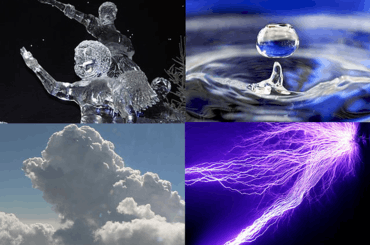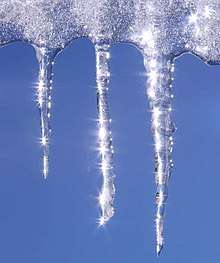Freezing
Freezing is a phase transition where a liquid turns into a solid when its temperature is lowered below its freezing point. In accordance with the internationally established definition, freezing means the solidification phase change of a liquid or the liquid content of a substance, usually due to cooling[1][2].
Although some authors differentiate solidification from freezing as a process where a liquid turns into a solid by increasing the pressure, the two terms are used interchangeably.
For most substances, the melting and freezing points are the same temperature; however, certain substances possess differing solid–liquid transition temperatures. For example, agar displays a hysteresis in its melting point and freezing point. It melts at 85°C (185°F) and solidifies from 32°C to 40°C (89.6°F to 104°F).[3]
Crystallization
Most liquids freeze by crystallization, formation of crystalline solid from the uniform liquid. This is a first-order thermodynamic phase transition, which means that as long as solid and liquid coexist, the temperature of the whole system remains very nearly equal to the melting point due to slow removal of heat when in contact with air, which is a poor heat conductor. Because of the latent heat of fusion, the freezing is greatly slowed and the temperature will not drop any more once the freezing starts but will continue dropping once it finishes. Crystallization consists of two major events, nucleation and crystal growth. Nucleation is the step wherein the molecules start to gather into clusters, on the nanometer scale, arranging in a defined and periodic manner that defines the crystal structure. The crystal growth is the subsequent growth of the nuclei that succeed in achieving the critical cluster size. The thermodynamics of freezing and melting is a classical discipline within physical chemistry,[4] which nowadays develops in conjunction with computer simulations.[5]
Supercooling
In spite of the second law of thermodynamics, crystallization of pure liquids usually begins at a lower temperature than the melting point, due to high activation energy of homogeneous nucleation. The creation of a nucleus implies the formation of an interface at the boundaries of the new phase. Some energy is expended to form this interface, based on the surface energy of each phase. If a hypothetical nucleus is too small, the energy that would be released by forming its volume is not enough to create its surface, and nucleation does not proceed. Freezing does not start until the temperature is low enough to provide enough energy to form stable nuclei. In presence of irregularities on the surface of the containing vessel, solid or gaseous impurities, pre-formed solid crystals, or other nucleators, heterogeneous nucleation may occur, where some energy is released by the partial destruction of the previous interface, raising the supercooling point to be near or equal to the melting point. The melting point of water at 1 atmosphere of pressure is very close to 0 °C (32 °F, 273.15 K), and in the presence of nucleating substances the freezing point of water is close to the melting point, but in the absence of nucleators water can supercool to −40 °C (−40 °F, 233 K) before freezing.[6][7] Under high pressure (2,000 atmospheres) water will supercool to as low as −70 °C (−94 °F, 203 K) before freezing.[8]
Exothermicity
Freezing is almost always an exothermic process, meaning that as liquid changes into solid, heat and pressure are released. This is often seen as counter-intuitive,[9] since the temperature of the material does not rise during freezing, except if the liquid were supercooled. But this can be understood since heat must be continually removed from the freezing liquid or the freezing process will stop. The energy released upon freezing is a latent heat, and is known as the enthalpy of fusion and is exactly the same as the energy required to melt the same amount of the solid.
Low-temperature helium is the only known exception to the general rule.[10] Helium-3 has a negative enthalpy of fusion at temperatures below 0.3 K. Helium-4 also has a very slightly negative enthalpy of fusion below 0.8 K. This means that, at appropriate constant pressures, heat must be added to these substances in order to freeze them.[11]
Vitrification
Certain materials, such as glass and glycerol, may harden without crystallizing; these are called amorphous solids. Amorphous materials, as well as some polymers, do not have a freezing point, as there is no abrupt phase change at any specific temperature. Instead, there is a gradual change in their viscoelastic properties over a range of temperatures. Such materials are characterized by a glass transition that occurs at a glass transition temperature, which may be roughly defined as the "knee" point of the material's density vs. temperature graph. Because vitrification is a non-equilibrium process, it does not qualify as freezing, which requires an equilibrium between the crystalline and liquid state.
Freezing of living organisms
Many living organisms are able to tolerate prolonged periods of time at temperatures below the freezing point of water. Most living organisms accumulate cryoprotectants such as anti-nucleating proteins, polyols, and glucose to protect themselves against frost damage by sharp ice crystals. Most plants, in particular, can safely reach temperatures of −4 °C to −12 °C. Certain bacteria, notably Pseudomonas syringae, produce specialized proteins that serve as potent ice nucleators, which they use to force ice formation on the surface of various fruits and plants at about −2 °C.[12] The freezing causes injuries in the epithelia and makes the nutrients in the underlying plant tissues available to the bacteria.[13]
Bacteria
Three species of bacteria, Carnobacterium pleistocenium, as well as Chryseobacterium greenlandensis and Herminiimonas glaciei, have reportedly been revived after surviving for thousands of years frozen in ice.
Plants
Many plants undergo a process called hardening, which allows them to survive temperatures below 0 °C for weeks to months.
Animals
The nematode Haemonchus contortus can survive 44 weeks frozen at liquid nitrogen temperatures. Other nematodes that survive at temperatures below 0 °C include Trichostrongylus colubriformis and Panagrolaimus davidi. Many species of reptiles and amphibians survive freezing. See cryobiology for a full discussion.
Human gametes and 2-, 4- and 8-cell embryos can survive freezing and are viable for up to 10 years, a process known as cryopreservation.
Experimental attempts to freeze human beings for later revival are known as cryonics.
Food preservation
Freezing is a common method of food preservation that slows both food decay and the growth of micro-organisms. Besides the effect of lower temperatures on reaction rates, freezing makes water less available for bacteria growth.
See also
 |
To | ||||
|---|---|---|---|---|---|
| Solid | Liquid | Gas | Plasma | ||
| From | Solid | Melting | Sublimation | ||
| Liquid | Freezing | Vaporization | |||
| Gas | Deposition | Condensation | Ionization | ||
| Plasma | Recombination | ||||
References
- International Dictionary of Refrigeration, http://dictionary.iifiir.org/search.php
- ASHRAE Terminology, https://www.ashrae.org/technical-resources/free-resources/ashrae-terminology
- "All About Agar". Sciencebuddies.org. Archived from the original on 3 June 2011. Retrieved 2011-04-27.
- Atkins PW (2017). Elements of physical chemistry. ISBN 978-0-19-879670-1. OCLC 982685277.
- Pedersen UR, Costigliola L, Bailey NP, Schrøder TB, Dyre JC (August 2016). "Thermodynamics of freezing and melting". Nature Communications. 7 (1): 12386. Bibcode:2016NatCo...712386P. doi:10.1038/ncomms12386. PMC 4992064. PMID 27530064.
- Lundheim R (July 2002). "Physiological and ecological significance of biological ice nucleators". Philosophical Transactions of the Royal Society of London. Series B, Biological Sciences. 357 (1423): 937–43. doi:10.1098/rstb.2002.1082. PMC 1693005. PMID 12171657.
- Franks F (March 2003). "Nucleation of ice and its management in ecosystems" (PDF). Philosophical Transactions. Series A, Mathematical, Physical, and Engineering Sciences. 361 (1804): 557–74, discussion 574. Bibcode:2003RSPTA.361..557F. doi:10.1098/rsta.2002.1141. PMID 12662454. S2CID 25606767.
- Jeffery CA, Austin PH (November 1997). "Homogeneous nucleation of supercooled water: Results from a new equation of state". Journal of Geophysical Research. 102 (D21): 25269–25280. Bibcode:1997JGR...10225269J. CiteSeerX 10.1.1.9.3236. doi:10.1029/97JD02243.
- What is an exothermic reaction? Scientific American, 1999
- Atkins P, Jones L (2008), Chemical Principles: The Quest for Insight (4th ed.), W. H. Freeman and Company, p. 236, ISBN 978-0-7167-7355-9
- Ott JB, Boerio-Goates J (2000). Chemical Thermodynamics: Advanced Applications. Academic Press. pp. 92–93. ISBN 0-12-530985-6.
- Maki LR, Galyan EL, Chang-Chien MM, Caldwell DR (September 1974). "Ice nucleation induced by pseudomonas syringae". Applied Microbiology. 28 (3): 456–9. doi:10.1128/aem.28.3.456-459.1974. PMC 186742. PMID 4371331.
- Zachariassen KE, Kristiansen E (December 2000). "Ice nucleation and antinucleation in nature". Cryobiology. 41 (4): 257–79. doi:10.1006/cryo.2000.2289. PMID 11222024.
External links
| Look up freezing in Wiktionary, the free dictionary. |

- Video of an intermetallic compound solidifying/freezing
